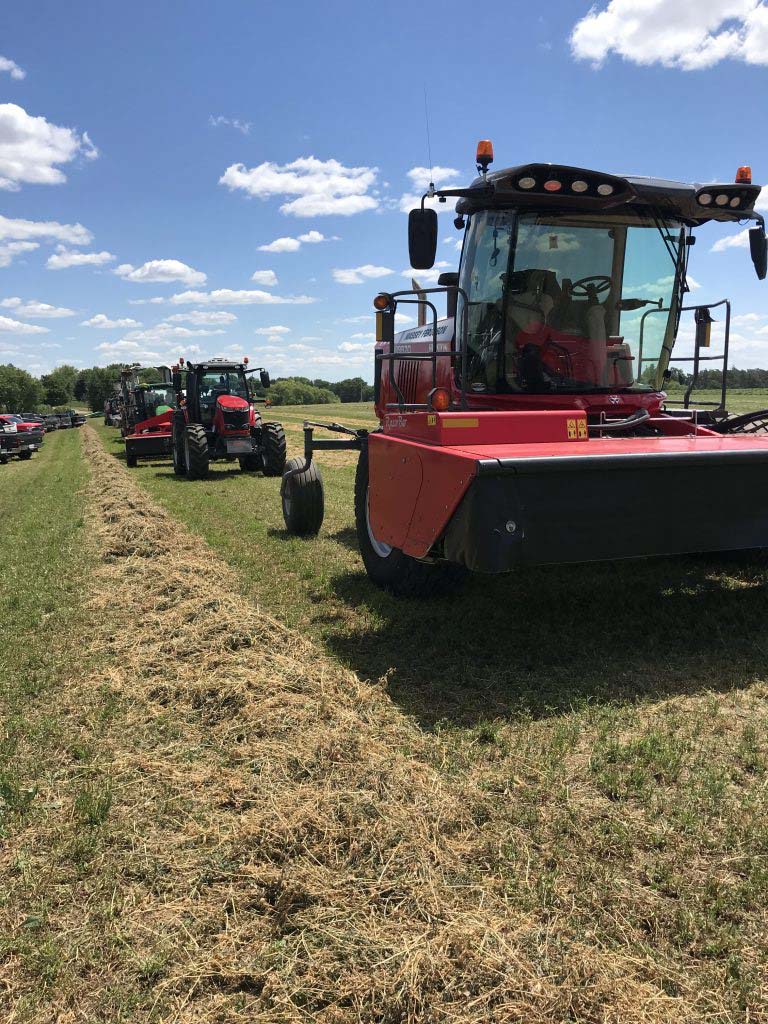Back to Innovator ~~~ Next article ~~~ Previous article
By Emily McKague, Georgian Central Regional SCIA
July 14, 2022, marked the return of the Ontario Forage Expo after a two-year hiatus due to COVID-19. The event was a resounding success with over fifty pieces of equipment onsite for exhibition and roughly 400 people in attendance.
Ontario Forage Expo is run by the Ontario Forage Council (OFC) and was held in conjunction with the Waterloo Soil and Crop Improvement Association (SCIA). It was generously hosted by Scott and Darlene Martin who farm on the outskirts of St. Jacobs.
Ian McDonald, Crop Innovations Specialist, OMAFRA, was involved in coordinating the demonstrations throughout the day. He commented that he was “pleased as punch with how this year’s event turned out.” One of the unique things about Forage Expo, in his opinion, is the variety of producers who attend. He said that you can have a beef farmer with 50 cows a dairy producer who milks 1,000 head, and a cash cropper with hay in the rotation all growing the same crop on different scales. Accordingly, there was a good range of equipment on display to fit the variety of needs in the audience.
The day’s events kicked off with welcoming remarks from Terry Nuhn, OFC president, and then moved quickly into demonstrations run by Ian McDonald. Mowing-conditioning equipment made their passes through the alfalfa first, followed by tedders and rakes, and balers after the lunch break. In addition to traditional hay making equipment, an in-field tire deflation/inflation system, a pre-production model individual bale wrapper, a small square bale bundler, forage harvesters, silage dump boxes, a silage bunk packer, and drone technology for spray and seeding were all demonstrated.

McDonald mentioned that one piece of equipment which intrigued him was an Italian-made Repossi wheel rake. He noted that wheel rakes are typically notorious for placing rocks in windrows and causing damage to baling equipment as a result. The double wheel design of the Italian rake is new to Canada and could address that problem.
In general, McDonald said that hay producing equipment hasn’t changed hugely over the decades, although the introduction of disc mowers and large square balers has improved capacity immensely. With hay being a low- density, high-volume crop, he said that producers need to look for the bottleneck in their system, which is often the ability to move bales safely and efficiently from the field to storage. He looks forward to including more accumulator equipment for demonstration in coming years.

The wide variation in operations producing hay make it necessary to exhibit equipment with a variety of features. Manufacturers had the opportunity for a rapid-fire review of their machine and its features before sending it off for a pass down the field. Audience members heard and saw the results of many innovations both new and old. Side- by-side comparison was made for mower conditioning with steel drum, rubber roller and flail conditioners or no conditioning options at all on machines targeted to silage production.
A Case tractor showed off turf tires which minimized both compaction and damage to live alfalfa crowns. A John Deere large square baler knotter finished the knot in a loop, which improved knot strength and had no cut ‘tails’ of twine loose in the bale. A self-propelled harvester with an option for locking the rear wheels when in road mode demonstrated a safer ability to steer. A bale monitoring program which maps where bales are dropped in the field and helps producers find them after dark was displayed. Many manufacturers spoke about quick change knife systems, easy access to key mechanical components for maintenance, and mechanical configurations meant to reduce wear on the machine and prolong its lifespan.
Not only were equipment suppliers on site, but there was a tradeshow at the field’s edge, which included seed companies, hay acid suppliers, inoculant product representatives and much more. It was truly an excellent representation of all major components of the forage production industry. The OFC, Waterloo SCIA, and OMAFRA should all be proud to have brought back such an excellent event with so much value for producers who attended.
For more information on the equipment on display at this years’ Forage Expo, visit: Ontario Forage Expo 2022. Mark your calendars now for the 2023 edition!
Back to Innovator ~~~ Next article ~~~ Previous article